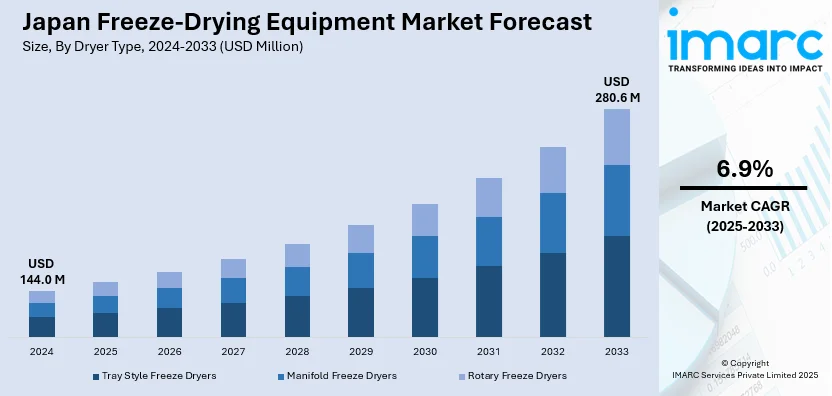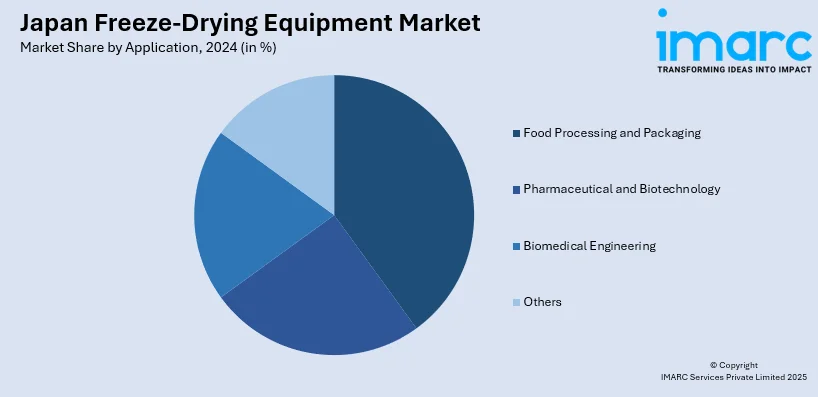
Japan Freeze-Drying Equipment Market Size, Share, Trends and Forecast by Dryer Type, Scale of Operation, Application, and Region, 2025-2033
Japan Freeze-Drying Equipment Market Overview:
The Japan freeze-drying equipment market size reached USD 144.0 Million in 2024. Looking forward, IMARC Group expects the market to reach USD 280.6 Million by 2033, exhibiting a growth rate (CAGR) of 6.9% during 2025-2033. The market is driven by the high demand for biologics, vaccines, and personalized medicines, shifting tastes towards nutritional, convenient, and long-shelf-life foods, and integration of Industry 4.0 solutions like Internet of Things (IoT)-based monitoring systems.
|
Report Attribute
|
Key Statistics
|
|---|---|
|
Base Year
|
2024 |
|
Forecast Years
|
2025-2033
|
|
Historical Years
|
2019-2024
|
| Market Size in 2024 | USD 144.0 Million |
| Market Forecast in 2033 | USD 280.6 Million |
| Market Growth Rate 2025-2033 | 6.9% |
Japan Freeze-Drying Equipment Market Trends:
Innovations in Pharmaceutical and Biotechnology Sector
Japan's biotechnology and pharmaceutical sectors are driving the demand for freeze-drying (lyophilization) equipment. Being one of the top pharmaceutical producers, Japan is experiencing a high demand for biologics, vaccines, and personalized medicines, all of which need sophisticated preservation methods to ensure product stability and efficacy. Freeze-drying is critical in these markets for extending shelf life, facilitating safe storage, and improving product transportability. Besides this, as per the government data, in 2024, the number of elderly people in the country increased from 20,000 to 36.25 million. The aging Japanese population and the high incidence of chronic conditions also contribute to an even greater demand for injectables, which are usually lyophilized. Moreover, due to enhanced government support towards domestic drug manufacture and investment in regenerative medicine, the research and development (R&D) and manufacturing base shows a significant growth. This trend leads to an increasing purchase of freeze-drying systems by pharmaceutical companies to satisfy quality requirements established by Japan's Pharmaceuticals and Medical Devices Agency (PMDA) for ensuring safety and efficacy in drug development and commercialization.

Rising Demand for High-Quality Packaged and Functional Foods
Preferences of individuals are shifting towards nutritional, convenient, and long-shelf-life foods, which is catalyzing the demand for freeze-drying technologies in the food processing segment. Freeze-dried foods best preserve nutritional values, taste, and texture compared to other dehydrating technologies, which meet the expectations of people in Japan. As increased focus is placed on healthy consumption and functional foods across health-oriented, as well as aging, people, products like freeze-dried fruits, instant soups, and meal supplements are becoming popular. In addition, the shift to single-member households and lifestyles in urban settings accelerates interest in ready-to-consume, quickly rehydratable foods, especially seafood options. As a result, Japanese food processors are making significant investments in energy-efficient, automated freeze-drying machinery for the diversification of product ranges without compromising nutrition integrity. According to the IMARC Group, the Japan frozen seafood market size is expected to reach USD 984.3 Million by 2033.
Technological Advancements and Automation Integration
Technological enhancements are bolstering the market growth in Japan. Companies are increasingly incorporating Industry 4.0 solutions like Internet of Things (IoT)-based monitoring systems, predictive maintenance, and data-driven process optimization into lyophilization units. These technologies greatly improve operational efficiency, lower energy consumption, and enhance product quality factors critical to industries with high process controls like pharmaceuticals and food and beverage (F&B). Japanese firms are also investing in modular and scalable systems that provide flexibility to support different production capacities, ranging from pilot to large-scale production. Automation is also a focus area, which reduces human touch, contamination risks, and compliance with regulatory requirements more effectively. The emphasis on cleanroom-compatible designs and closed systems indicates the market's transition towards increased hygiene and traceability. Since Japan continues to pioneer automation and robotics, the addition of smart technology to freeze-drying machines presents manufacturers with an advantage, generating additional market expansion through productivity and innovation. As per the IMARC Group’s predictions, the Japan robotics market size is expected to reach USD 3.2 Billion by 2033.
Japan Freeze-Drying Equipment Market Segmentation:
IMARC Group provides an analysis of the key trends in each segment of the market, along with forecasts at the region level for 2025-2033. Our report has categorized the market based on dryer type, scale of operation, and application.
Dryer Type Insights:
- Tray Style Freeze Dryers
- Manifold Freeze Dryers
- Rotary Freeze Dryers
The report has provided a detailed breakup and analysis of the market based on the dryer type. This includes tray style freeze dryers, manifold freeze dryers, and rotary freeze dryers.
Scale of Operation Insights:
- Industrial Scale Freeze Dryer
- Pilot Scale Freeze Dryer
- Laboratory Scale Freeze Dryer
A detailed breakup and analysis of the market based on the scale of operation have also been provided in the report. This includes industrial scale freeze dryer, pilot scale freeze dryer, and laboratory scale freeze dryer.
Application Insights:

- Food Processing and Packaging
- Pharmaceutical and Biotechnology
- Biomedical Engineering
- Others
A detailed breakup and analysis of the market based on the application have also been provided in the report. This includes food processing and packaging, pharmaceutical and biotechnology, biomedical engineering, and others.
Regional Insights:
- Kanto Region
- Kansai/Kinki Region
- Central/ Chubu Region
- Kyushu-Okinawa Region
- Tohoku Region
- Chugoku Region
- Hokkaido Region
- Shikoku Region
The report has also provided a comprehensive analysis of all the major regional markets, which include Kanto region, Kansai/Kinki region, Central/ Chubu region, Kyushu-Okinawa region, Tohoku region, Chugoku region, Hokkaido region, and Shikoku region.
Competitive Landscape:
The market research report has also provided a comprehensive analysis of the competitive landscape. Competitive analysis such as market structure, key player positioning, top winning strategies, competitive dashboard, and company evaluation quadrant has been covered in the report. Also, detailed profiles of all major companies have been provided.
Japan Freeze-Drying Equipment Market Report Coverage:
| Report Features | Details |
|---|---|
| Base Year of the Analysis | 2024 |
| Historical Period | 2019-2024 |
| Forecast Period | 2025-2033 |
| Units | Million USD |
| Scope of the Report | Exploration of Historical Trends and Market Outlook, Industry Catalysts and Challenges, Segment-Wise Historical and Future Market Assessment:
|
| Dryer Types Covered | Tray Style Freeze Dryers, Manifold Freeze Dryers, Rotary Freeze Dryers |
| Scale of Operations Covered | Industrial Scale Freeze Dryer, Pilot Scale Freeze Dryer, Laboratory Scale Freeze Dryer |
| Applications Covered | Food Processing and Packaging, Pharmaceutical and Biotechnology, Biomedical Engineering, Others |
| Regions Covered | Kanto Region, Kansai/Kinki Region, Central/ Chubu Region, Kyushu-Okinawa Region, Tohoku Region, Chugoku Region, Hokkaido Region, Shikoku Region |
| Customization Scope | 10% Free Customization |
| Post-Sale Analyst Support | 10-12 Weeks |
| Delivery Format | PDF and Excel through Email (We can also provide the editable version of the report in PPT/Word format on special request) |
Key Questions Answered in This Report:
- How has the Japan freeze-drying equipment market performed so far and how will it perform in the coming years?
- What is the breakup of the Japan freeze-drying equipment market on the basis of dryer type?
- What is the breakup of the Japan freeze-drying equipment market on the basis of scale of operation?
- What is the breakup of the Japan freeze-drying equipment market on the basis of application?
- What are the various stages in the value chain of the Japan freeze-drying equipment market?
- What are the key driving factors and challenges in the Japan freeze-drying equipment market?
- What is the structure of the Japan freeze-drying equipment market and who are the key players?
- What is the degree of competition in the Japan freeze-drying equipment market?
Key Benefits for Stakeholders:
- IMARC’s industry report offers a comprehensive quantitative analysis of various market segments, historical and current market trends, market forecasts, and dynamics of the Japan freeze-drying equipment market from 2019-2033.
- The research report provides the latest information on the market drivers, challenges, and opportunities in the Japan freeze-drying equipment market.
- Porter's five forces analysis assist stakeholders in assessing the impact of new entrants, competitive rivalry, supplier power, buyer power, and the threat of substitution. It helps stakeholders to analyze the level of competition within the Japan freeze-drying equipment industry and its attractiveness.
- Competitive landscape allows stakeholders to understand their competitive environment and provides an insight into the current positions of key players in the market.
Need more help?
- Speak to our experienced analysts for insights on the current market scenarios.
- Include additional segments and countries to customize the report as per your requirement.
- Gain an unparalleled competitive advantage in your domain by understanding how to utilize the report and positively impacting your operations and revenue.
- For further assistance, please connect with our analysts.
 Request Customization
Request Customization
 Speak to an Analyst
Speak to an Analyst
 Request Brochure
Request Brochure
 Inquire Before Buying
Inquire Before Buying




.webp)




.webp)












